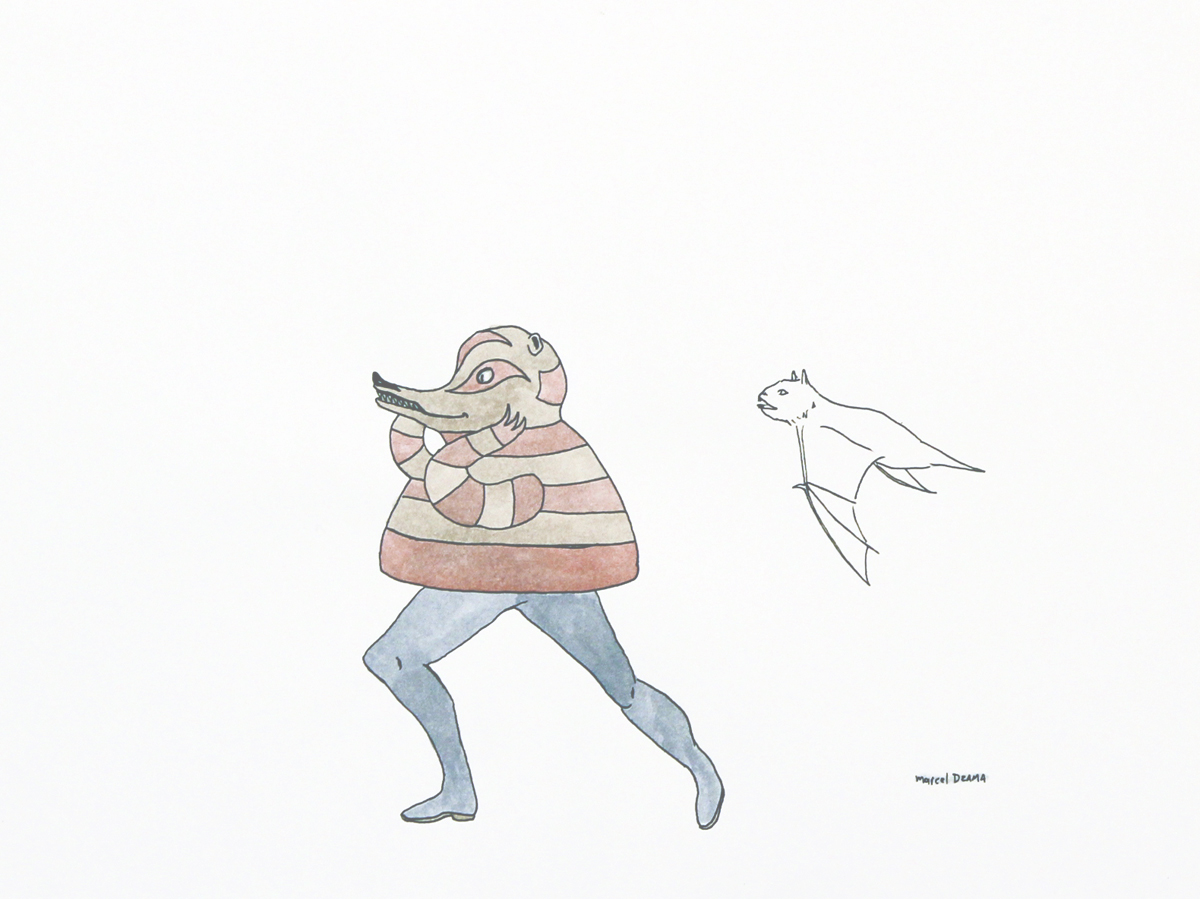
Dzama, Marcel, Untitled #7, ca.1998, Ink and watercolour, 12 1/2 x 9 3/4 in.
Exhibition opened November 12, 2013
The Great Watcher
I was weaving a tapestry containing the maze
of this
city and the palace, and I sent a swift-footed
ragazzo
to lose himself in it, until he found you. I
understood that the tapestry would bring me another
lover. It
doesn’t matter, that is how it always happens:
truth
begins or ends by evaporating. I will await
you in a
circular room, constellated with birds, on the
threshold of that door full of night and world,
which
opens onto the unalterable. Like dedicating
an
unfinished poem to a little girl, giving it to her
to
warp when suffering no longer seems a more
authentic, spacious land. I will elongate the
road to
the unsayable. I will be the act of weaving.
You, the
leopard of multiple horns that has now just
appeared
on the green brocade and is observing it all
like a
herald, enigmatically.
Richard Boulet, a gifted artist living in Edmonton forwarded the poem above, entitled The Great Watcher, by the Argentinian poet Maria Negroni. It is a haunting visual poem of spatial and emotional displacement, subtle touches of surrealism, and the sensuously absurd. In its flow of images the poem lays bare more than one momento mystico that in combination open a portal to interpreting the visionary art crafted by Boulet. Thank you Richard. It is an added bonus when truly poetic passages illuminate the brilliant artwork of other artists as well. Negroni’s poetic dream does just that. It offers a novel point of entry to Marcel Dzama’s figurative drawings from the 1990’s in the Plug In ICA Archive. Dzama’s work shares common ground in their sense of remove, bringing uncertainty and a provocative strangeness into focus via a general inability to pinpoint the multiple sources of inspiration.

Dzama, Marcel
SUITS ME, ca. 1997
Ink and watercolour
9 x 12 in.
Negroni’s poem alludes to interior designs melding into exterior spaces. The beauty of a ragazzo (is such beauty tangible?) lands on the haunted, textured surface of brocade (curtains?) that separates reality from metaphor. The voyeur and birds alike are mutually silent. The Great Watcher depicts a dramatic encounter of one fleeting form with another and then another, on and on, each encounter more voyeuristic than the last. The refracted voyeuristic self is entirely imaginary and loosely inserted amidst representation of visionary domestic architecture and an expansive landscape. Both the poem and Dzama’s drawings are purposefully anachronistic, a bitter sweet and deeply felt humour from an idiosyncratic and emotionally reflective position. It is this combination of increasingly abstract forms and emotions that “elongate the road to the unsayable” in Dzama’s work.
Negroni’s poem draws forth allusions just as slippery in spirit as we might find in Dzama’s genius drawings. His single cells feature a slew of modified pigs, bears, lovers, tinker toys, mutant forms and unidentified Others, mostly endearing but simultaneously menacing. In each drawing Nature appears to be on a course to defeat the human attempt to triumph over it. But it is often impossible to identify the sentimental underpinning associated with Nature in each quirky drawing. They are nothing if not brilliantly original and each one remarkable on its own terms as pure drawing. Could the Dzama drawings simply offer the ultimate metaphor for the artmaking process?
To exorcise the overlapping sentimental qualities of each drawing is to stylistically rework the children’s book as source material in narrative and visual structure. Dzama is a master at creating sentimental hooks between Nature and Man’s follies. Add to this stylistic mélange a frustrated vision of progress, a provocative raw sense of personal innocence, and the belief that comics art is already ensconced in the realm of high art and you have an approach to drawing that is truly and consistently free spirited. The drawings in the Feheley Fine Arts exhibition represent the formative style of Dzama’s countless mixed media drawings, sculptures, films and installations into the 21st-century. This exhibition presents important drawings, each a proposition that has travelled the elongated road of his first public exhibitions in Winnipeg, Vancouver, Rio de Janeiro, Sao Paulo, Montreal and Los Angeles.
Wayne Baerwaldt.
Director, Illingworth Kerr Gallery, Calgary
November 2013
